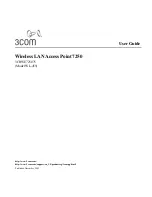
4-11
bytes). Under 1 Mbit/s transmit rate, the management frames sent by the AP require 675 ms, and occupy nearly 70% of the
channels. With other AP-related detection response frames, the management frames occupy nearly 80% of the channels.
When the AP replies a detection response frame, the detection response frame and the Authentication frame are considered
as management frames and transmitted in the same priority queue. When the channel environment is poor, the detection
response frame cannot be transmitted in a timely manner. As a result, the Authentication frame is blocked in the hardware
queue, and a delay occurs.
The defined Authentication timeout durations vary with STAs. As a result, certain network adapters cannot be associated, for
example, D-Link DWA125.
Therefore, when the network environment is poor and network adapter association is difficult, you can address the issues by
optimizing the network in the following aspects:
Setting the rate set: Restrict the low-rate packets to improve the transmit rate of the management frames, and ensure normal
network adapter association.
Disabling the broadcast detection response: Reduce the number of management frames to improve the transmit efficiency of
the Authentication packets.
Using a clean environment: Check whether the test users can be associated in a shielding room or on a 5G network.
Improving the QoS contention parameters: Improve the channel contention capability of the management frames.
Q3: What are limitations of the shared VLAN of the STA in local forwarding mode and the AP?
the AP are in the same broadcast domain. If a large number of APs are deployed in the same VLAN, the ARP broadcast
packets of an AP and its STA are sent to another AP. The CPU of the AP that receives a large number of broadcast packets
is shocked, and the ARP packets from the AP's gateway may be hidden in other ARP packets and are aged. As a result, the
AP communication is abnormal. Therefore, do not deploy a large number of APs in the same VLAN in this solution.
Q4: In 11.1(5)B5 and later version , can a STA, , whose RSSI lower than the specified response RSSI be associated
after several times of trying?
The association is allowed after two rejections. If the association persists rejected, run strict-limit response-rssi in ac-controller
mode (a hidden command and saved by data writing).
Q5: Why STA can't automatically be associated?
1 The manually disconnected SSID cannot be automatically associated, which is a normal phenomenon.
2 If a laptop requires automatic association, the auto association option should be selected.












































